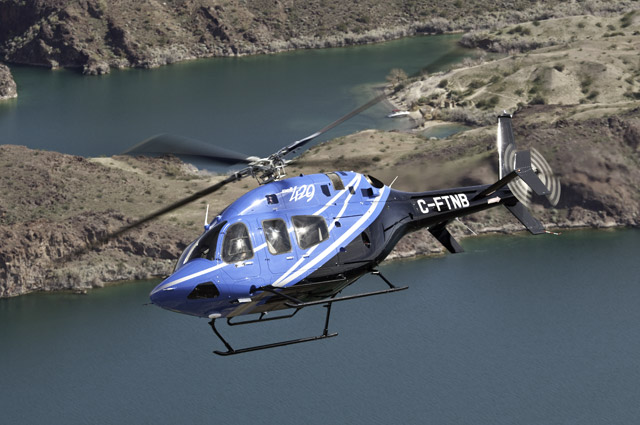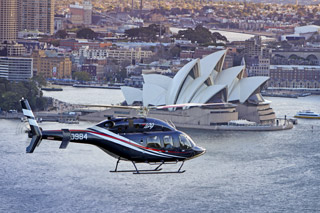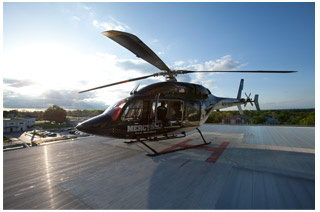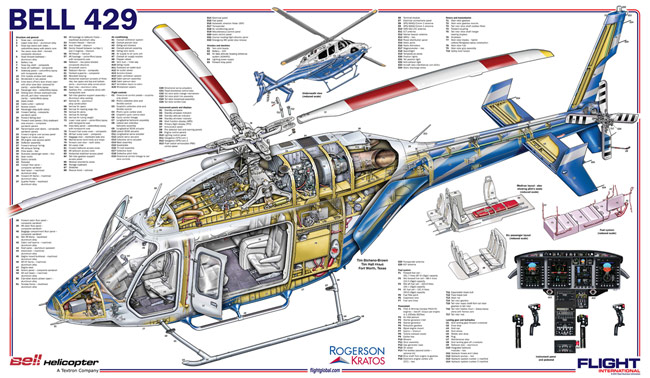Bell Helicopter has learned some lessons with the 429 GlobalRanger, starting from the very beginning, when production of its forerunner 427 was suspended in 2003 after mediocre sales.
A substandard cockpit for instrumented flight rules and cabin size for emergency medical services were to blame. Bell's original concept for the 429 - dubbed the 427s3i in 2004 - fixed the avionics issue, but failed to address the shortfall in cabin space.
After returning briefly to the drawing board in Fort Worth, Bell came back with a 429 airframe based on its modular affordable product line (MAPL) concept.
 |
| Bell The 429's market appeal is spreading |
Nearly twice the size by volume of the baseline 427, the MAPL-based 429 finally featured the spacious cabin interior prized by EMS customers, who are so critical to sales in the highly competitive light-twin market.
The MAPL-based 429 concept was first introduced more than seven years ago. In the interim, Bell has continued to learn more lessons on the programme, including the limits of modular components and bespoke integrated avionics systems. Along the way, the 429 also became the centre of an unusual regulatory feud, with hundreds of possible sales at stake on the outcome.
Within Bell, however, the 429's most important lesson is perhaps this helicopter's role in leading the way to a revival of the company's commercial portfolio. Until the launching of the 429 in 2005, Bell was consumed for more than a decade with its military products, especially on its share of the Bell Boeing V-22 Osprey.
The introduction into service of the 429 three years ago and its spreading market appeal represent a return to a more balanced product focus within the Fort Worth, Texas-based company.
As arguably Bell's first all-new civil airframe since introducing the 222 light-twin nearly 40 years ago, the 429 paved the way for a broader commercial product revival that now includes upgrades to the 407 and 412EP. It is also the forerunner to Bell's biggest gamble since perhaps the V-22 itself - the super-medium 525 Relentless - which was launched earlier this year.
PROMISING RETURNS
The early returns for the 429 have been promising. Bell delivered 28 429s last year in the first full year of production, and that output could be multiplied in 2012, even as some of the intended regional and topical markets for the light-twin are still barely tapped.
The 429 may be a trailblazer within Bell, but it was not completely original. Despite boasting an all-new airframe, its similarity with the external lines of the 206 JetRanger is unmistakable - but not identical. Bell consciously focused on maximizing the visibility from the crew seats.
 |
| Bell Bell borrowed the four-bladed rotor and beefed-up 820kW transmission from the abandoned 427 |
"The side windows are very low, and come down below the seats so the pilot can look off to the side and see below the aircraft very easily," says Van Wilson, Bell's 429 programme manager. "Those are standard windows. That's not an optional feature to have in the aircraft."
Bell borrowed the four-bladed rotor and beefed-up, 1,100shp (820kW) transmission from the abandoned 427. The two engines of the 429 are a slightly more powerful variant of the 427's Pratt & Whitney PW207D1, which each can develop 621shp in cruise.
But it is the 429's transmission that sets it apart. Its closest competitor in the light-twin market has similar engine power, but a weaker transmission. Compared with other light-twins, the 429's 1,100shp-rated system allows the engines to produce more effective power in the low air densities of higher altitude.
It was that power that proved most persuasive to Air Zermatt, Switzerland's famous mountain rescue service. In mid-September, Air Zermatt became the launch customer for the 429 in Europe, a market usually dominated by Bell's Italian and Franco-German competitors.
NICHE MARKETS
Although the 429's high-altitude power is useful in niche markets, the heart of its intended appeal in the broader market is the design of its cabin.
Featuring a composite and aluminium structure for a two-person crew and up to six passengers, the airframe is composed of three main sections - forward, intermediate and tailboom. The forward section ends at the bulkhead aft of the passenger cabin, with the intermediate section housing the baggage area. Combined, these two sections create an internal cabin volume of 5.78m³ (204ft³), nearly double the capacity of the original 427 airframe.
The space is quickly noticeable in a club-style seating layout for passengers. "Passengers are sitting there facing each other and they are not interlocking knees," Wilson says. "They'll sit there and they're not knocking knees the whole time."
For the crew seats, Bell does not argue with claims that its previous commercial models suffered from a more Spartan, military-oriented view of creature comfort.
"I would agree with that," Wilson says. "On the 206 and the 427 we had uncomfortable seats, and it probably was an evolution from the military side."
On the 429, the crew seats are designed to provide comfort across the spectrum of people sized between 5ft (1.5m) and 6ft 2in, with adjustability forward and aft, and up and down.
"Depending on what country you're delivering in, that's a big deal because even if you have predominantly male pilots, if you go to countries in, say, the Asia-Pacific region, males are typically a lot smaller, and if you design something that works for 5ft 8in to 6ft 2in males, that may be a problem in other parts of the world," says Ryan Weeks, chief engineer for commercial programmes.
At the rear of the cabin is another feature that is easy to overlook, yet indicates the degree of Bell's interest in getting the smallest details right on the 429. Competitors had previously introduced clamshell doors, allowing especially EMS customers direct access to loading patients from the rear of the aircraft. Bell also added clamshell doors to the 429, but added a hinging mechanism that folds them back along the fuselage.
"It's a great design. I'm very impressed with the design we did on that," Wilson says. "They are very easy to open and when they do open, they hug the fuselage so they are not sticking out and getting in people's way if they are back there, or if it's windy, they're not flapping around in the wind."
Control over such details is also evident in Bell's decision to design the integrated avionics system for the 429. Called the BasiX Pro flight deck, it features the capability to fly an approach assisted by wide area augmentation system/localiser performance with vertical guidance (WAAS/LPV). A 429 pilot can therefore fly steep approaches of up to 9˚ with forward speeds as low as 45kt (83km/h) on autopilot.
"Really, what this does for operators, which for instance operate EMS and come into the same landing zone every time, such as a hospital, is that they can set up an LPV approach," Wilson says. "It allows them to operate in more adverse conditions and go do missions when they wouldn't normally be able to do that."
BasiX Pro is delivered from the factory with two multi-function displays for the right-hand crew seat. The 429 is certified to operate under single-pilot instrument flight rules (IFR). A third multi-function display, supplied by Rogerson Kratos, can be ordered optionally for the left-hand crew seat.
 |
| Bell A larger cabin size suits emergency services |
On one of the displays is a power situation indicator (PSI). Eurocopter pioneered the idea of using a single digital gauge to present multiple power and engine settings with the first limit indicator (FLI). Bell's PSI offers a similar capability, essentially combining six gauges into one.
"That's a single display to look at to monitor your exceedances on power, speed and temperature, so you don't have to be looking at several different instruments to see what you're doing," Wilson says.
Two Garmin GNS430 navigation systems are delivered from the factory, but about 90% of customers substitute one of the systems with the larger-format GNS530. The autopilot comes standard with control of pitch, yaw and roll. An optional fourth axis can be added to include thrust control.
The combined avionics package is impressively ambitious for an airframer to undertake. Such capabilities are usually contracted to an avionics specialist such as Garmin, Rockwell Collins or Honeywell. The experience developing the 429 avionics offered Bell yet another lesson, one seemingly learned the hard way.
"As you see on our next product, where we did a glass cockpit on the 407GX, we went with a different approach and we went to a provider to integrate that for us," Wilson says. "I see it as more of a strategy moving forward with Bell, moving towards more integrated systems from suppliers."
Weeks agrees. "It's an evolution," he says. "Instead of trying to do everything ourselves, like other industries, we'll let the specialists define what it is they are great at and then we incorporate it all."
EVOLVING PHILOSOPHY
Avionics integration is not the only challenge on the 429 that Bell now acknowledges was a bit of an over-reach. The original MAPL concept called for integrating modular airframe sections that could be easily re-sized for smaller and larger variants. In the first half of the decade, Bell touted 429 MAPL as a whole new way for the industry to cheaply introduce new helicopters sized to meet specific requirements for customers.
But little of the original MAPL philosophy survived the transition from the drawing board to the aircraft now in production. Meanwhile, Bell has pulled back from its original vision of a modular airframe with many spin-offs.
"That vision wasn't fully realised," Wilson says. "Being able to easily take something that's developed for this size of helicopter and apply it to another size of helicopter - it's difficult to do that."
Instead, Bell has shifted its focus on modularity from the airframe to more fundamental components of new rotorcraft.
"Where I see us focusing a lot of attention on that front now is, let's develop technologies at least, or materials or processes and capabilities that are readily transferable across product lines," Weeks says.
An example of such a technology, Wilson adds, is composite structures, a technology Bell first learned on the V-22, applied on the 429 and is now refining for the 525.
"We've slowly evolved that and learned more for each project," Wilson says. "The 429 is - the external structure is - all composite. Internal is aluminum. We learned a lot on 429 with composites, and we've brought that over to the 525."
Making airframes that are easy to scale between sizes tends to increase the weight, a line on the specification chart that continues to be a challenge for the 429.
In fact, Bell applied for an exemption to the 3,180kg (7,010lb) limit for a helicopter certified under the Part 27 standard for non-transport category aircraft. Bell asked regulators to approve a 227kg weight increase to the 429, claiming that the extra fuel or safety equipment could increase the helicopter's addressable market by hundreds of sales.
The exemption was necessary only because Bell missed its weight target for the 429.
"I think just as the product was being developed it increased in weight," says Danny Maldonado, Bell's executive vice-president of sales and marketing. "As they started introducing new requirements and you start putting additional safety equipment, it's just going to move in that direction."
Twelve regulatory authorities accepted Bell's request, including Transport Canada which had approved the 429's original airworthiness certificate under Part 27.
But the US Federal Aviation Administration denied Bell's request for an exemption, setting up a rare stand-off with fellow regulators at Transport Canada and raising questions about the future of the increased gross weight (IGW) version of the 429.
Bell has already delivered the first 429 IGW variant to a customer in Brazil, where regulators cleared the exemption request. But the variant's future depends substantially on Bell's ability to operate the aircraft in the company's largest market - the USA.
An appeal filed by Bell is still working its way through the FAA bureaucracy.
"There is something within the guidelines that says you can appeal it and resubmit information and maybe counter what they submitted back," Maldonado says.
The FAA's stance is based on the existing regulations that somewhat arbitrarily set higher safety standards for helicopters weighing more than 3,180kg. Such aircraft fall underneath the Part 29 regulations, which also require an airframe that can survive an impact with a 0.68kg bird as well as components, such as rotor blades, that are able to tolerate a single flaw introduced in production.
For Bell, the debate should be about what makes the aircraft safer. The IGW exemption allows an operator to add more safety equipment or fly longer distances without having to remove optional safety equipment or passengers.
"All we're doing is allowing them to put more safety equipment on, to meet all the requirements that the FAA has established," Maldonado says. "The whole idea was to make safer products and this allows us to do that."
Source: Flight International

















